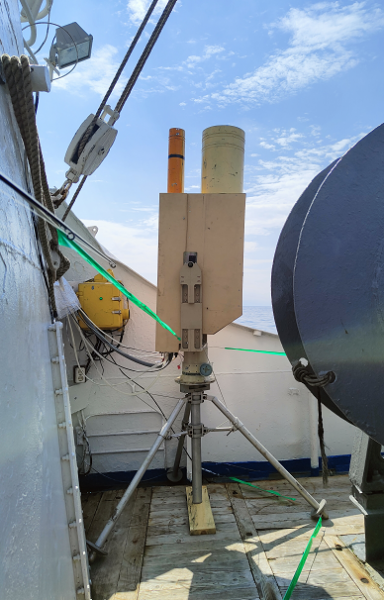Short report on the expedition on board the R/V “Vereshchagin” on August 05-15, 2023
On August 5-15, 2023 a complex expedition on board the R/V “Vereshchagin” was carried out within the RNF project “Studies of the Composition and Spatio-Temporal Distribution of Aerosol-Gas Impurities of the Atmosphere in the Water Area of Lake Baikal” (19-77-20058-P) and the State assignment of the Institute “Study of the role of atmospheric deposition on aquatic and terrestrial ecosystems of the Lake Baikal basin, identification of sources of atmospheric pollution” (0279-2021-0014) (led by Khodzher T.V.). The expedition route covered the entire perimeter of Lake Baikal with stops in the area of large local sources of atmospheric pollution on the lake coast, estuaries of large tributaries and bays.
Significant current climate changes caused by anthropogenic factors and forest fires have a great impact on the processes in the atmosphere and hydrosphere of the earth. Flow from the atmosphere of various pollutants (soot PAHs, biogenic elements, heavy metals, etc.) to the Baikal water area is an important indicator for controlling the quality of its waters, which predetermines the need to control their dynamics.
The aim of the expedition is to assess the contribution of anthropogenic sources of Pribaikalye and natural hazard events (forest fires) to atmospheric pollution over Lake Baikal in summer and to forecast possible consequences of atmospheric deposition on its water quality using complex continuous measurements of gas impurities, aerosol and meteorological parameters.
With participation of staff of four institutes of SB RAS (LIN, IPM, IAO, ISTP) during the expedition, experimental continuous measurements in the lake atmosphere were carried out using the mobile aerosol-Raman lidar “LOZA-M2”, gas analyzers, particle counters, and aerosol was sampled for various chemical analyses.
Lidar “LOZA-M2” is a multi-frequency lidar system using as a source of radiation Nd:YAG-laser, it was used to measure atmospheric aerosol fields over the lake (Fig.1). During the measurement period, the receiving system gets signals due to elastic scattering for wavelengths (532, 1064 nm) with a vertical resolution of 6 m, which enables to examine in detail the changes in the tropospheric aerosol up to heights of 10-12 km. Within the expedition, the characteristic day variation due to turbulent exchange was clearly manifested during the daytime hours, as a result of which the surface aerosol layer was lifted to heights of 600-800 m (internal mixing layer (Fig. 2, а). Above, the layers of the planetary boundary layer up to 1600 m were distinguished with weakly pronounced stratification due to the erosion of inverse gradients under cyclonic weather conditions during this period. More pronounced aerosol layers were observed during the period of vessel call to Barguzinsky Bay (Fig. 2,в). As the ship moved towards Ust-Barguzin settlement, the density of aerosol filling, especially inside the boundary layer (up to heights of 1500 m), increased significantly. In addition, a second stable layer was observed at the heights from 1800 to 2400 m, probably connected with long-range transport of aerosol under the conditions of drift of air masses of the west and northwest directions to the water area of the Barguzin Bay.
The spatio-temporal variability of small gas (SO2, NOx, O3) and aerosol impurities of different size fractions (PM1, PM2.5, PM10) were investigated. Concentrations of PM10 particles varied from 1 to 12 µg/m3 with the highest values in the Southern Baikal Basin (10-12 µg/m3). In the Middle Basin, the changes ranged from 3 to 4 µg/m3, in the Northern Basin from 1 to 2 µg/m3. In general, the aerosol mass concentrations obtained during the expedition period were commensurate with the results of 2022, and significantly lower than those obtained during large fires in 2020. Methodical work was carried out to compare the results of measurements between the gas analyzers installed on the eastern (Boyarsky station) and western (Listvyanka station) shores of the lake.
The mass concentration of the absorbing substance in the atmospheric aerosol (soot, black carbon) in the driving atmosphere was determined by the aethalometer MDA developed by IOA SB RAS. The instrument was calibrated with black carbon particles, the absorption of radiation was reduced to the equivalent of the mass concentration of black carbon in the air eBC(µg/m3). The concentrations of BC in the driving atmosphere of the lake varied from 0.07 to 6.3 µg/m3. In the Northern Basin, the concentrations of BC within 0.2-0.3 µg/m3 were recorded with a minimum in the night hours on August 10 in Ayaa Bay - 0.07-0.1 µg/m3. The obtained values characterize the background values encountered over the seas of the Russian Arctic. The highest concentrations of black carbon were recorded at the mouth of the Angara River and near large settlements with a maximum value of 6.3 µg/m3 on August 6 at 10 a.m. near the town of Slyudyanka.
Meteorological and turbulent characteristics of the atmosphere were analyzed using acoustic meteorological complex “Meteo-2”. The process of suppression of turbulent processes over the lake surface was investigated. Data will be used for further analysis of their influence on spatio-temporal variability of aerosol and gas fields.
During the expedition 25 samples of atmospheric aerosol are taken for ionic, elemental composition, PAHs, soot, which will be analyzed in the laboratory. The planned expeditionary works were carried out in full. Further processing of the complex expedition results will be carried out at institutes participants.
















